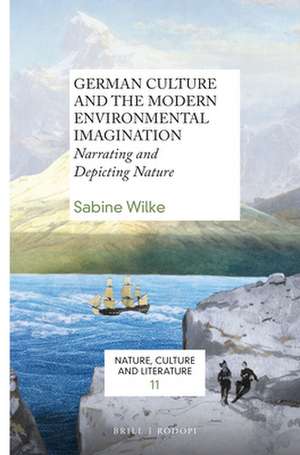German Culture and the Modern Environmental Imagination: Narrating and Depicting Nature: Nature, Culture and Literature, cartea 11
Autor Sabine Wilkeen Limba Engleză Paperback – apr 2015
Preț: 360.19 lei
Preț vechi: 423.76 lei
-15% Nou
Puncte Express: 540
Preț estimativ în valută:
68.92€ • 72.22$ • 56.98£
68.92€ • 72.22$ • 56.98£
Carte indisponibilă temporar
Doresc să fiu notificat când acest titlu va fi disponibil:
Se trimite...
Preluare comenzi: 021 569.72.76
Specificații
ISBN-13: 9789004297852
ISBN-10: 9004297855
Pagini: 236
Dimensiuni: 155 x 235 x 18 mm
Greutate: 0.41 kg
Editura: Brill
Colecția Brill
Seria Nature, Culture and Literature
ISBN-10: 9004297855
Pagini: 236
Dimensiuni: 155 x 235 x 18 mm
Greutate: 0.41 kg
Editura: Brill
Colecția Brill
Seria Nature, Culture and Literature
Cuprins
Preface
1. The German environmental imagination
1.1 A brief history of the environmental humanities
1.2 German philosophy and environmental thought
1.3 An environmental perspective in German Studies
1.4 Chapter breakdown
2. Environmental aesthetics and the German intellectual tradition
2.1 Nature as nature
2.2 Nature as construct
2.3 Mediating nature and construction
2.4 Kant and the sublime
2.5 Nature in critical theory
2.6 Nature philosophy
3. Alexander von Humboldt and the modern environmental imagination
3.1 Envisioning geographic spaces
3.2 Profiling mountains
3.3 Performing tropical nature
3.4 Nature as cosmos
4. Transatlantic dialogues on nature: art, theater and beyond
4.1 German romantic landscapes
4.2 Albert Bierstadt and the American West
5. Nature on the move: from landscape to modern cinema
5.1 The German mountain film
5.2 Fanck versus Riefenstahl
5.3 Postwar legacies of the mountain film
6. Staging nature: polar performances
6.1 Forster’s polar discourse
6.2 Legacies of Forster’s polar discourse
7. Colonial nature: negotiating the tropics
7.1 Humboldt’s tropics
7.2 Humboldt’s legacy
7.3 Herzog’s untropicalized tropics
8. Beyond the modern German environmental imagination
Bibliography
Index
1. The German environmental imagination
1.1 A brief history of the environmental humanities
1.2 German philosophy and environmental thought
1.3 An environmental perspective in German Studies
1.4 Chapter breakdown
2. Environmental aesthetics and the German intellectual tradition
2.1 Nature as nature
2.2 Nature as construct
2.3 Mediating nature and construction
2.4 Kant and the sublime
2.5 Nature in critical theory
2.6 Nature philosophy
3. Alexander von Humboldt and the modern environmental imagination
3.1 Envisioning geographic spaces
3.2 Profiling mountains
3.3 Performing tropical nature
3.4 Nature as cosmos
4. Transatlantic dialogues on nature: art, theater and beyond
4.1 German romantic landscapes
4.2 Albert Bierstadt and the American West
5. Nature on the move: from landscape to modern cinema
5.1 The German mountain film
5.2 Fanck versus Riefenstahl
5.3 Postwar legacies of the mountain film
6. Staging nature: polar performances
6.1 Forster’s polar discourse
6.2 Legacies of Forster’s polar discourse
7. Colonial nature: negotiating the tropics
7.1 Humboldt’s tropics
7.2 Humboldt’s legacy
7.3 Herzog’s untropicalized tropics
8. Beyond the modern German environmental imagination
Bibliography
Index
Notă biografică
Sabine Wilke is professor of German at the University of Washington.
Recenzii
“German ecocritical scholarship is rapidly growing, with Sabine Wilke’s volume being a milestone in the formation of a new canon. With German Culture and the Modern Environmental Imagination, Wilke manages to offer an introduction and brief history of German environmental thought; consider disciplines as diverse as aesthetics, art, film, and literature; address discourses from the tropics to the poles; and pull together an impressive array of scholarship. Thus her volume is bound to become a handy standard to introduce the environmental views of German thinkers, researchers, and artists from Immanuel Kant to Alexander von Humboldt, Georg Forster, and Werner Herzog, and to familiarize oneself and one’s students more generally with German environmental contexts.” - Caroline Schaumann, Emory University, in: Monatshefte 108.3 (2016), pp. 407-409
“Sabine Wilke astutely notes that nature, as it is seen in all artistic or descriptive forms, is staged – founded upon the theatricality inherent to nature. This moment, this point of human engagement with nature, is the flashpoint where humanity processes the experience by way of language and art. Wilke offers in this book, taking her examples from German literature and visual art, a compelling articulation and examination of this moment, and demonstrates its continual renewal in the shape of the new and different framings that drive the evolution of the modern environmental imagination.” - Mark W. Person, University of Wyoming, in: Environmental Values 25.2 (2016), pp. 250-252
“While Wilke’s book reflects on the ecocritical potential that resides in dynamics of visual perception, it is also an aesthetic experience in itself. Equipped with a very suitable collage-style landscape cover and featuring many multi-coloured illustrations of pictures and images that she mentions throughout, it is a beautiful addition to Brill’s Nature, Culture and Literature series.” - Simone Schröder, University of Bath, UK, in: Green Letters: Studies in Ecocriticism 20.2, pp. 221-222
“Sabine Wilke astutely notes that nature, as it is seen in all artistic or descriptive forms, is staged – founded upon the theatricality inherent to nature. This moment, this point of human engagement with nature, is the flashpoint where humanity processes the experience by way of language and art. Wilke offers in this book, taking her examples from German literature and visual art, a compelling articulation and examination of this moment, and demonstrates its continual renewal in the shape of the new and different framings that drive the evolution of the modern environmental imagination.” - Mark W. Person, University of Wyoming, in: Environmental Values 25.2 (2016), pp. 250-252
“While Wilke’s book reflects on the ecocritical potential that resides in dynamics of visual perception, it is also an aesthetic experience in itself. Equipped with a very suitable collage-style landscape cover and featuring many multi-coloured illustrations of pictures and images that she mentions throughout, it is a beautiful addition to Brill’s Nature, Culture and Literature series.” - Simone Schröder, University of Bath, UK, in: Green Letters: Studies in Ecocriticism 20.2, pp. 221-222









